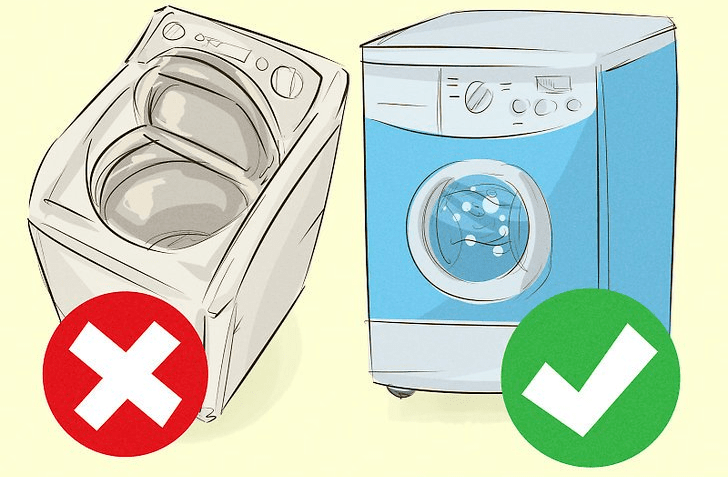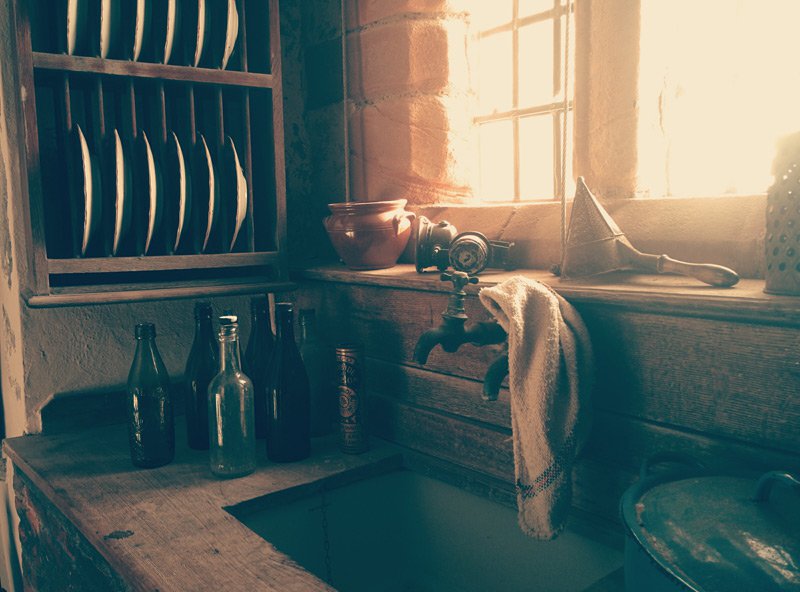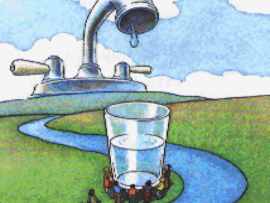Toilets
Don’t Use the Toilet as an Ashtray or Wastebasket
Every time you flush a cigarette butt, facial tissue, or other small bit of trash, you’re wasting gallons of water. Put them in the garbage, or better yet, recycle.
Put Plastic Bottles or a Float Booster in Your Toilet Tank
To cut down on water waste, put an inch or two of sand or pebbles inside each of two plastic bottles. Fill the bottles with water, screw the lids on, and put them in your toilet tank, safely away from the operating mechanisms. Or, buy an inexpensive tank bank or float booster. This may save ten or more gallons of water per day. Be sure at least three gallons of water remain in the tank so it will flush properly. If there is not enough water to get a proper flush, users will hold the lever down too long or do multiple flushes to get rid of waste. Two flushes at 1.4 gallons are worse than a single 2 gallon flush.
Buy an Adjustable Toilet Flapper
Installing an adjustable toilet flapper will allow for adjustment of each per flush use; the user can adjust the flush rate to the minimum per flush setting that achieves a single good flush each time.
Install Low or Dual Flush Models
Federal regulations state that new toilets must use no more than 1.6 gallons per flush. Replacing an old toilet with an ultra-low volume (ULV) 1.6 gallon flush model represents a 70% savings in water and will cut indoor water use by about 30%. Alternatively, consider purchasing a dual flush toilet or installing a dual flush converter that turns a standard toilet into a dual flush toilet, saving an average family 15,000 gallons of water each year. More water can be used when it’s needed, but for most flushes you’ll be using 70% less, adding up to some significant water savings.
Install Composting Toilets
Composting toilets are the most effective way to cut water waste from your bathroom since they require no water at all! Better still, they keep all the nutrients and pollutants out of waterways and make them available for use in non-food landscapes. Check codes in your area to be sure they’re legal before installing one. Read our article about composting toilets to find out if they’re right for you.
Laundry
Use Clothes Washer for Only Full Loads
With clothes washers, avoid the permanent press cycle, which uses an added 5 gallons (20 liters) for the extra rinse. For partial loads, adjust water levels to match the size of the load.
Consider a High Efficiency Washing Machine
The most efficient washing machines use as little as seven gallons per load, compared to a whopping 54 for a traditional washer. A high efficiency (HE) washer should easily pay for itself over its lifetime in water and energy savings. New Energy Star rated washers use 35 – 50% less water and 50% less energy per load. If you’re in the market for a new clothes washer, read our article about water-saving frontload washers.

Shower
Install Water-Saving Showerheads, Shower Timers, and Low-Flow Faucet Aerators
Inexpensive water-saving low-flow showerheads or restrictors are easy for the homeowner to install. Long showers can use five to ten gallons every unneeded minute. “Low-flow” means it uses less than 2.5 gallons per minute. You can easily install a ShowerStart, or add a ShowerStart converter to existing showerheads, which automatically pauses a running shower once it gets warm.
Take Shorter Showers
One way to cut down on water use is to turn off the shower after soaping up, then turn it back on to rinse. A four-minute shower uses approximately 20 to 40 gallons of water. You can also install a simple shower timer, available from Eartheasy or your local water utility.

Faucets and Sinks
Fit Household Faucets with Aerators
This easy and effective home water conservation method is also the cheapest! A simple low-flow aerator saves water in the bathroom, while a swiveling aerator can serve multiple purposes in the kitchen
Turn Off the Water After You Wet Your Toothbrush
There is no need to keep the water running while brushing your teeth. Just wet your brush and fill a glass for mouth rinsing.
Rinse Your Razor in the Sink
Fill the sink with a few inches of warm water. This will rinse your razor just as well as running water, with far less waste of water.
Minimize Use of Kitchen Sink Garbage Disposal Units
In-sink ‘garburators’ require lots of water to operate properly, and also add considerably to the volume of solids in a septic tank, which can lead to maintenance problems. Start a compost pile as an alternate method of disposing food waste.
Opt for the Dishwasher Over Hand Washing
It may seem counterintuitive, but it turns out washing dishes by hand uses a lot more water than running the dishwasher, even more so if you have a water-conserving model. The EPA estimates an efficient dishwasher uses half as much water, saving close to 5,000 gallons each year.
When Washing Dishes by Hand, Don’t Leave the Water Running for Rinsing
If your have a double-basin, fill one with soapy water and one with rinse water. If you have a single-basin sink, gather washed dishes in a dish rack and rinse them with a spray device or a pan full of hot water. Dual-swivel aerators are available to make this easier. If using a dishwasher, there is usually no need to pre-rinse the dishes.
Don’t Let the Faucet Run While You Clean Vegetables
Just rinse them in a stoppered sink or a pan of clean water. Use a dual-setting aerator.
Keep a Bottle of Drinking Water in the Fridge
Running tap water to cool it off for drinking water is wasteful. Store drinking water in the fridge in a safe drinking bottle. If you are filling water bottles to bring along on outdoor hikes, consider buying a personal water filter, which enables users to drink water safely from rivers or lakes or any available body of water.

Leaks
Check Faucets and Pipes for Leaks
A small drip from a worn faucet washer can waste 20 gallons of water per day. Larger leaks can waste hundreds of gallons. Some faucet leaks are easily spotted, but others take a little more effort to locate. Dry sinks and tubs thoroughly and allow to sit for an hour. If you notice wetness, you’ve found a leak. To find leaks from faucet handles, dry the area around them before running water. You’ll see water collecting next to them if there’s a leak.
Check Your Toilets for Leaks
Put a little food coloring in your toilet tank. If, without flushing, the color begins to appear in the bowl within 30 minutes, you have a leak that should be repaired immediately. Most replacement parts are inexpensive and easy to install.
Use Your Water Meter to Check for Hidden Water Leaks
Read the house water meter before and after a two-hour period when no water is being used. If the meter does not read exactly the same, there is a leak.
Extending Your Conservation Measures
Insulate Your Water Pipes
It’s easy and inexpensive to insulate your water pipes with pre-slit foam pipe insulation. You’ll get hot water faster plus avoid wasting water while it heats up.
Recycle Your Water Where You Can
Collect the cold water you run before it’s hot enough to shower and use it to water plants or flush the toilet (known as a bucket flush). Rinse water from dishes and food preparation can be collected and used to soak other dishes.
Eat Less Water-Intensive Foods
Our diets account for roughly half of all the water we use. All food has a water footprint, but some are much larger than others. Eating less beef, one of the most water-intensive foods, is a smart place to start. Shifting away from animal products to a plant-based diet can shrink your water footprint significantly.
Buy Less
Consumer products are an often-overlooked source of water use, accounting for up to a third of most people’s water footprint. Buying less of everything—from clothing to electronics to household goods—can dramatically decrease your water footprint.

Tags:
5 methods of water conservation, new methods of water conservation, simple ways to save water, how to save water in daily life, 5 ways to conserve water, ways to conserve water , how can we conserve water in our home.

